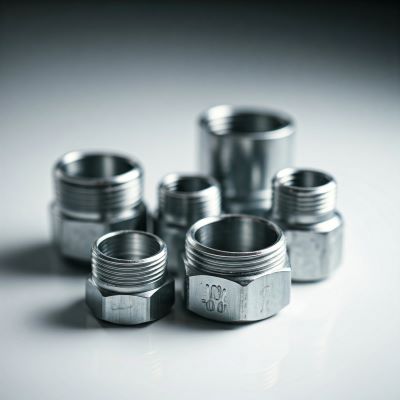Metric hose fittings are essential components in a wide range of fluid systems, from automotive and aerospace to industrial machinery. These fittings ensure secure and efficient connections, preventing leaks and maintaining system integrity. In this blog post, we will delve into the world of metric hose fittings, exploring their characteristics, benefits, and applications.
Understanding Metric Hose Fittings
Metric hose fittings are designed to connect hoses and pipes using metric threads. They are characterized by their precise dimensions and standardized design, enabling easy compatibility with various fluid systems.
Key differences between metric and imperial fittings
Metric and imperial fittings differ primarily in their units of measurement. Metric fittings use millimeters, while imperial fittings use inches. This distinction is crucial, as using the wrong type of fitting can lead to leaks, damage, and system failure.
Why Metric Hose Fittings are Essential in Fluid Systems
Metric hose fittings adhere to international standards, making them widely compatible with fluid systems across the globe. This universal adaptability simplifies maintenance and replacement processes.
The precise dimensions of metric fittings ensure accurate and reliable connections in hydraulic systems. This minimizes the risk of leaks and maximizes system efficiency.
Types of Metric Hose Fittings
Overview of common types, including compression fittings, flared fittings, and push-to-connect fittings:
➡️ Compression fittings: These fittings rely on a compression ring to create a tight seal between the hose and fitting. They are versatile and suitable for a wide range of applications.
➡️ Flared fittings: These fittings use a flared end on the hose to create a seal within the fitting. They are commonly used in high-pressure applications.
➡️ Push-to-connect fittings: These fittings offer quick and easy installation, as they require no tools. They are ideal for low-pressure applications.
Materials Used in Metric Hose Fittings
Metric hose fittings are typically made from durable and corrosion-resistant materials, such as:
➡️ Stainless steel: Offers excellent strength, durability, and corrosion resistance, making it suitable for harsh environments.
➡️ Brass: Provides good conductivity and machinability, making it ideal for a wide range of applications.
➡️ Aluminum: Lightweight and corrosion-resistant, making it suitable for aerospace and automotive applications.
The choice of material for a metric hose fitting depends on the specific application and the properties required. For example, stainless steel fittings are ideal for high-pressure, high-temperature, and corrosive environments, while brass fittings are suitable for general-purpose applications.
Applications of Metric Hose Fittings in Various Industries
➡️ Automotive: Ensuring efficient fuel and hydraulic connections
Metric hose fittings are crucial in the automotive industry, ensuring efficient fuel and hydraulic connections for braking, steering, and power systems.
➡️ Aerospace: High-performance fittings for pressurized systems
In the aerospace industry, metric hose fittings must withstand extreme pressures and temperatures. High-quality, lightweight fittings made from materials like stainless steel and aluminum are commonly used.
➡️ Industrial machinery: Maintaining operational efficiency in heavy equipment
Metric hose fittings play a vital role in maintaining the operational efficiency of industrial machinery. They ensure reliable fluid connections for hydraulic systems, lubrication systems, and pneumatic systems.
Advantages of Metric Hose Fittings in Fluid Connections
➡️ Precision engineering for a leak-proof seal
Metric hose fittings are manufactured with precision, ensuring a tight and leak-proof seal. This reduces the risk of fluid leaks and system failures.
➡️ Reduced maintenance costs due to enhanced durability
High-quality metric hose fittings are designed to withstand harsh conditions and minimize the need for frequent replacements. Over time, this can result in considerable cost savings.
➡️ Universal adaptability in international markets
The standardized design of metric hose fittings makes them compatible with fluid systems worldwide, simplifying maintenance and replacement processes.
Challenges in Using Metric Hose Fittings
➡️ Potential issues with compatibility in mixed systems
Mixing metric and imperial fittings can lead to compatibility issues, as the thread sizes and dimensions may not match. It is essential to use fittings of the same standard to avoid leaks and damage.
➡️ The need for accurate measurements and installation techniques
Proper installation of metric hose fittings requires accurate measurements and techniques. Incorrect installation can lead to leaks, damage, and system failure.
Installation and Maintenance Best Practices
It is crucial to select the correct type and size of metric hose fitting for the specific application. Refer to manufacturer’s specifications and industry standards to ensure proper selection.
Tips for avoiding common installation mistakes
➡️ Cleanliness: Ensure that the fittings, hoses, and pipes are clean and free of debris before installation.
➡️ Lubrication: Use a suitable lubricant to facilitate smooth assembly and prevent damage to the threads.
➡️ Tightening torque: Tighten the fittings to the recommended torque to ensure a secure connection without overtightening.
➡️ Inspection: Check the fittings frequently for leaks, wear, or damage.
Regular maintenance of metric hose fittings is essential to ensure system longevity and prevent failures. This includes inspecting for leaks, checking for damage, and replacing worn-out fittings.
Conclusion
Metric hose fittings play a crucial role in ensuring the reliable and efficient operation of fluid systems across various industries. By understanding their characteristics, benefits, and proper installation techniques, you can maximize their performance and minimize downtime.
When selecting metric hose fittings, prioritize quality and compatibility to achieve optimal results.
Post time: Dec-11-2024


